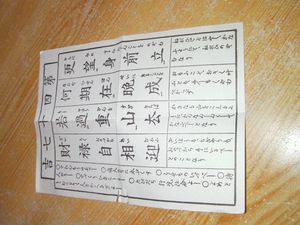It's impossible to talk of a visit of Tokyo without talking of the district of Asakusa, a district of the North-East of the city which is full of tourists... which can be explained by the famous monuments it contains (as the Sensô-ji) and by the concentration of souvenirs shops.
A short visit of Asakusa
In Asakusa (cf. Usefull informations), the most common choice of tourists is to pass though the huge gate which should be on your right if you arrive from Asakusa Station. Its name is Kaminari-mon, the door of the Thunder which contains in its pilars two Gods (of wind, on your left, and of lightning, on your right). The most impressive thing was, for me, the big lantern under which you will have to pass and... the shoes you will find attached on the left pilar after passing the gate: this giant shoe was forgotten by a giant bouddha some years ago...
Le Kaminari-mon côté Namikase-dôri
Once you have passed the Kaminari-mon, you arrive in Namikase Dôri (or street), particularly animated... and full of tourists. This is not a surprise as all the shops sell souvenirs or O-miyage, in Japanese: it is a tradition in Japan where a travel is always followed by a distribution of gifts for all the people who were aware of your trip (your colleagues, friends and family). If you do not do it, even if you are a foreigner, it does not go down well. The street Namikase will let you prepare your come-back to your home country with a lot of traditional gifts from Japan: engravings, cats, chopsticks, small Japanese pastries, flags, key chains or fans...
La Namikase dôri
At the end of this chain of shops of 500 meters, a new gate, called Hôzô-mon, anounces the entrance of the shrine Sensô-ji or Asakusa Kannon (name of the divinity to who it has been erected). It is the most ancient and known Tokyo's shrine: it appears that it was founded in 628 by three fishermen before being built as we saw it now in 1692. Although it was destroyed during the World War 2, it was identically built again. It is surrounded by many buildings, as a pagoda of 5th floors, on your left. On your right, a little farther, you should find the Asakusa-Jinja, a sanctuary which has been made to thank the three fishermen who founded the Sensô-ji. This little shrine is the point from where the procession of the Sanja-matsuri, the biggest shintoist festival of the world, begins each year, on the 3rd weekend of may, also to thank the three fishermen. If you are not in Japan on may, maybe you will be at the beginning of april: on the 8th, there is the Flower day and many children parade at the Sensô-ji.
Hôzô-mon
Sensô-ji
The visit of Asakusa is already almost done. Then, you can decide to reach Yoshiwara (around 1,5 kilometers away at the North), a former district of brothels of Edo (the former name of Tokyo) or choose to lose yourself in the little streets all around Asakusa Station. If you have to go back to the station and to the gate Azuma (or Azumabashi), do not forget to look up and to notice the golden flame on the building of the famous brend of Japanese bier: Asahi... a piece which was realized by a French designer: Philippe Starck.
Wish you a good visit !
Marièke Poulat
Little story: O-mikuji
If the number of tourist is sometimes a problem when you visit a country, it can also be an advantage... For instance, at the Sensô-ji, you will be able to read O-mikuji (good fortune teller) in English to try this Japanese tradition for 100 yens (while most of the time these littles papers are in ancien Japanese). An O-mikuji is a little paper you can pick or choose thanks to an explained ritual (you have to shake a box to receive a numeroted stick which indicates you which drawer you have to open). The paper you receive announces your fortune... and if it is a bad one, you can give up your little paper in the court-yard of the shrine: therefore, the gods will forget you.
Un O-mikuji
Usefull informations
Access: To access Asakusa, you have two options:
Asakusa stop on the Toei Asakusa Line which is the closest station from the Kaminari-mon.
For those who chosed the JR Pass and who prefers the use of Yamanote Line, you can get off at Ueno Station and walk. Go outside on Higashi Ueno 3 Exit and take the street Asakusa-Dôri. Walk straight for about one kilometer and turn left on the street Namikase-Dôri: after 200 meters, you cannot miss the Kaminari-mon in front of you.
Take a look on Google Map
Accomodation: Located on the closest part of Tokyo from Narita Airport, there are a lot of facilities to stay at Asakusa for really reasonnable prices (around 2000 yens for a night without breakfast). You also can stay longer, for one week or more, as there are some discounts for long stays in some of these accomodations. These places can be really fun even though it is not always really confortable (dorm or private rooms for 1,2 or 3 people but it is more expansive). One of these inns is les auberges Khaosan.





























